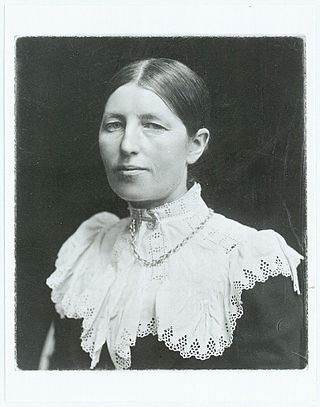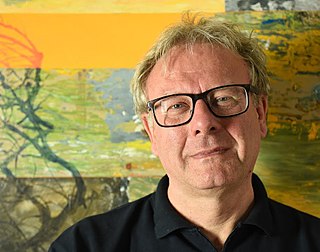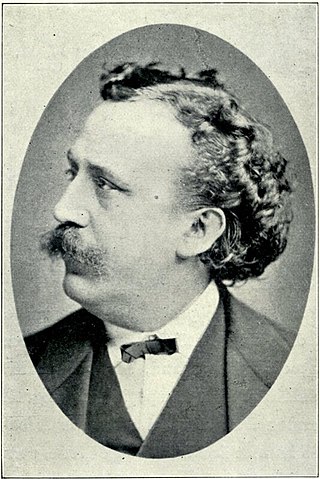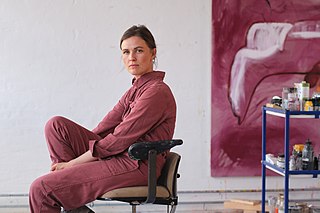
Peder Severin Krøyer, also known as P. S. Krøyer, was a Danish painter.

Anna Ancher was a Danish artist associated with the Skagen Painters, an artist colony on the northern point of Jylland, Denmark. She is considered to be one of Denmark's greatest visual artists.

Johan Julius Exner,, Danish genre painter, was born in Copenhagen to Johann Gottlieb Exner, a Czech musician from Bohemia, who came to Denmark during the Napoleonic period, and his wife Karen Jørgensdatter. Exner originally intended on becoming a history painter, but quickly found his niche, however, in genre painting, the most popular and lucrative painting style of his era. His genre paintings figured prominently in Denmark's National Romantic period, an artistic period directly after the Golden Age of Danish Painting, when artistic focus was turned inwards to uniquely Danish themes.

Niels Laurits Andreas Høyen is considered to be the first Danish art historian and critic. He promoted a Danish nationalistic art through his writings and lectures, and exerted a far reaching effect on contemporary artists. His work in various cultural institutions helped steer the development of Danish art during the mid-19th century.

Johan Thomas Lundbye was a Danish painter and graphic artist, known for his animal and landscape paintings. He was inspired by Niels Laurits Høyen's call to develop nationalistic art through depictions of Denmark's characteristic landscapes; the historical buildings and monuments, and the country's simple, rural people. He became one of his generation's national romantic painters, along with P. C. Skovgaard and Lorenz Frølich, to regularly depict the landscape of Zealand.

Laurits Andersen Ring was one of the foremost Danish painters of the turn of the 20th century, who pioneered both symbolism and social realism in Denmark. Considered one of the masterpieces of Danish culture, his painting Summer Day by Roskilde Fjord was included in the 2006 Danish Culture Canon.

Per Arnoldi is a Danish designer and artist. He has worked with many media, including painting, sculptures, ceramics and posters and has made designs for many companies, organisations and institutions, doing air planes, train stations, hospitals, architecture, monuments, stores, company profiles, handicrafts and everyday utensils. His characteristic simplistic expressions are often categorized as modern art. Arnoldi has worked in many countries around the world and is on permanent exhibit in several prestigious art and design institutions for his unique and influential productions, including Museum of Modern Art in New York.

Ann Lislegaard is a contemporary artist living and working in Copenhagen, Denmark and New York City, US. She is known for her 3D film animations and sound-light installations often departing from ideas found in science fiction. She finds in Science fiction an alternative approach to language, narration, gender roles and concepts of the future.
The Marinko Sudac Collection, based in Zagreb, Croatia, has been created with a clear collecting strategy based on the region of Central and Eastern Europe, additionally spanning from the Baltic area to the Black Sea. The guiding principle of the Collection is systematic exploration, researching, and promotion of the avant-garde practices which have been marginalized, forbidden, and at times completely negated due to the historical, social and political circumstances. In this context, the Marinko Sudac Collection gives the most complete and comprehensive overview on the art of this region. The Collection starts at 1909, and it show the continuity from the first Avant-Gardes, through neo-avant-garde and New Artistic Practices, ending with the fall of the Berlin Wall. The global uniqueness of the Marinko Sudac Collection is also seen in the kind of media it contains. It contains not only traditional artworks, such as paintings, sculptures, and photographs, but it gives equal importance to documentary and archival material. Great importance is put on these almost forgotten media, which enable research of specific phenomena, artists and the socio-political situation which affected this type of art. The Collection contains a great number of museological units, and it treats the documentary and archival material on the same level as traditional artworks. By examining the units contained in the Marinko Sudac Collection, one can read not only the art scene or the art production of a certain artist, but the full status of the society, the socio-political atmosphere of the region in which this art was created in.

Agnes Slott-Møller, née Rambusch, was a Danish Symbolist painter; influenced by the Pre-Raphaelites. She is known for works inspired by Danish history and folklore. Her husband was the painter Harald Slott-Møller.
Trine Søndergaard, is a Danish photography-based visual artist. Trine Søndergaard lives and works in Copenhagen, Denmark.

Ludvig Karsten was a Norwegian painter. He was a neo-impressionist influenced by Edvard Munch, Henri Matisse and contemporary French painting. He first participated at the Autumn exhibition in Kristiania in 1901, and had his first separate exhibition in 1904. He is represented at museums in many Scandinavian cities, including several paintings at the National Gallery of Norway. Karsten was known for his bohemian lifestyle and quick temper.

The Musée d'art moderne et d'art contemporain, also known as MAMAC, is a museum dedicated to modern art and contemporary art. It opened on 21 June 1990, in Nice, France.
The Danish Culture Canon consists of 108 works of cultural excellence in eight categories: architecture, visual arts, design and crafts, film, literature, music, performing arts, and children's culture. An initiative of Brian Mikkelsen in 2004, it was developed by a series of committees under the auspices of the Danish Ministry of Culture in 2006–2007 as "a collection and presentation of the greatest, most important works of Denmark's cultural heritage." Each category contains 12 works although music contains 12 works of score music and 12 of popular music and the literature section's 12th item is an anthology of 24 works.

Sommerdag ved Roskilde Fjord is an oil painting by the Danish artist L. A. Ring from 1900. Considered to be one of the masterpieces of Danish culture, it was included in the 2006 Danish Culture Canon. It is displayed in the Randers Museum of Art.

Lars Physant lives and works in Barcelona since 1994, is a Danish painter whose conceptual expression has its roots in naturalism and realism. Amongst his earliest influences are C.W. Eckersberg, Christen Købke, J.Th. Lundbye, Wilhelm Hammershøi, Vermeer van Delft, Claude Monet and Georges Seurat. He is especially known for his royal portraits and his concept of Multiversal Realism expressed on relief structures of wood.
Harald Rudyard Engman (1903-1968) was a Danish artist, painter. Above all, he is remembered for his fierce use of satire in criticizing and resisting the German occupation of Denmark during World War II.

Marie Henriques was a Danish painter who created landscapes, figure paintings and portraits, initially in the Realist style but increasingly under the influence of Impressionism. She also painted watercolours of ancient architecture and sculpture. In 1916, she was a founding member of the Society of Women Artists .

Bertel Christian Budtz Müller was a pioneering Danish photographer. He operated the photographic studio Budtz Müller & Co. at Bredgade 21 in Copenhagen and was appointed as court photographer in Denmark, Norway and Sweden.

Emily Gernild is a Danish painter and artist based in Copenhagen, Denmark.















